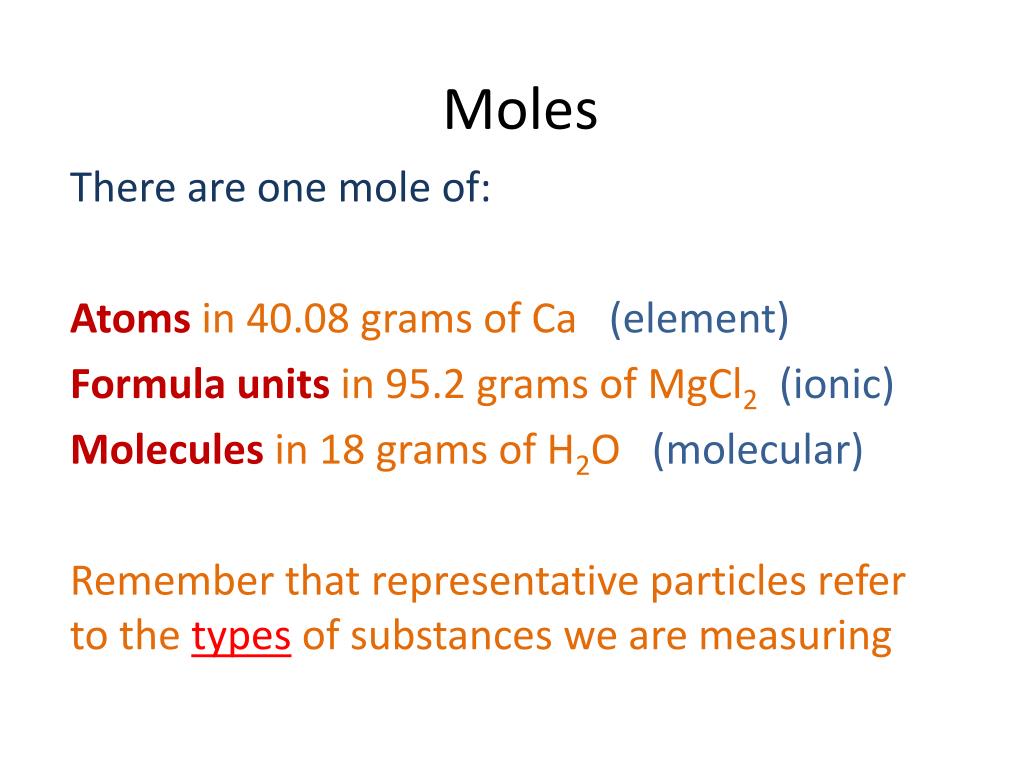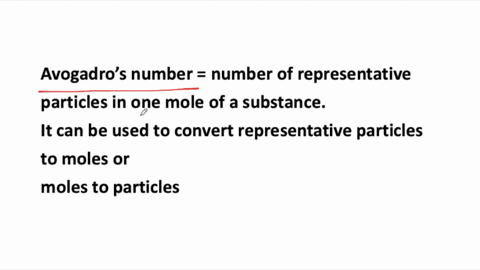Learning Objective
- Avogadro's Number Of Representative Particles Is Equal To One __
- Avogadro's Number Of Representative Particles Is Equal To One
- Avogadro's Number Of Representative Particles Is Equal To One __
- Define and memorize Avogadro’s number
Key Points

- The mole allows scientists to calculate the number of elementary entities (usually atoms or molecules) in a certain mass of a given substance.
- Avogadro’s number is an absolute number: there are 6.022×1023 elementary entities in 1 mole. This can also be written as 6.022×1023 mol-1.
- The mass of one mole of a substance is equal to that substance’s molecular weight. For example, the mean molecular weight of water is 18.015 atomic mass units (amu), so one mole of water weight 18.015 grams.
Term
- Avogadro’s number of representative particles is equal to one. The molar mass of a certain gas is 49 g. What is the density of the gas in g/L at STP? A 22.4 L sample of which of the following substances, at STP, would contain 6.02 x 10 23 representative particles: a) oxygen, or b) gold? What is the molar mass of AuCl 3?
- Avogadro's number of representative particles is equal to one (1 Point) liter Kelvin Mole Gram kilogram.
- Question: 4 Avogadro's Number Of Representative Particles Is Equal To One (1 (1 نقطة) Liter Kelvin Mole Gram Kilogram This problem has been solved!
- moleThe amount of substance of a system that contains as many elementary entities as there are atoms in 12 g of carbon-12.
The chemical changes observed in any reaction involve the rearrangement of billions of atoms. It is impractical to try to count or visualize all these atoms, but scientists need some way to refer to the entire quantity. They also need a way to compare these numbers and relate them to the weights of the substances, which they can measure and observe. The solution is the concept of the mole, which is very important in quantitative chemistry.
Avogadro’s Number

Amadeo Avogadro first proposed that the volume of a gas at a given pressure and temperature is proportional to the number of atoms or molecules, regardless of the type of gas. Although he did not determine the exact proportion, he is credited for the idea.
Avogadro’s number is a proportion that relates molar mass on an atomic scale to physical mass on a human scale. Avogadro’s number is defined as the number of elementary particles (molecules, atoms, compounds, etc.) per mole of a substance. It is equal to 6.022×1023 mol-1 and is expressed as the symbol NA.
Avogadro’s number is a similar concept to that of a dozen or a gross. A dozen molecules is 12 molecules. A gross of molecules is 144 molecules. Avogadro’s number is 6.022×1023 molecules. With Avogadro’s number, scientists can discuss and compare very large numbers, which is useful because substances in everyday quantities contain very large numbers of atoms and molecules.
The Mole
Avogadro's number of representative particles is equal to one. Avogadros number. One mole of a substance has the same number of particles as one mole. The Avogadro's number is equal to (6,022 x 10 raised to 23 particles) and is symbolized in the formulas with the letters L or NA. In addition, it is used to make conversions between grams and atomic mass unit.
The mole (abbreviated mol) is the SI measure of quantity of a “chemical entity,” such as atoms, electrons, or protons. It is defined as the amount of a substance that contains as many particles as there are atoms in 12 grams of pure carbon-12. So, 1 mol contains 6.022×1023 elementary entities of the substance.
Chemical Computations with Avogadro’s Number and the Mole
Avogadro’s number is fundamental to understanding both the makeup of molecules and their interactions and combinations. For example, since one atom of oxygen will combine with two atoms of hydrogen to create one molecule of water (H2O), one mole of oxygen (6.022×1023 of O atoms) will combine with two moles of hydrogen (2 × 6.022×1023 of H atoms) to make one mole of H2O.
Another property of Avogadro’s number is that the mass of one mole of a substance is equal to that substance’s molecular weight. For example, the mean molecular weight of water is 18.015 atomic mass units (amu), so one mole of water weight 18.015 grams. This property simplifies many chemical computations.

If you have 1.25 grams of a molecule with molecular weight of 134.1 g/mol, how many moles of that molecule do you have?
[latex]1.25g times frac{ 1 text{ mole}}{134.1g}=0.0093 text{ moles}.[/latex]
Show SourcesBoundless vets and curates high-quality, openly licensed content from around the Internet. This particular resource used the following sources:
http://www.boundless.com/
Boundless Learning
CC BY-SA 3.0.
http://www.chem1.com/acad/webtext/intro/int-2.html#SEC2
Steve Lower’s Website
CC BY-SA.
http://en.wiktionary.org/wiki/mole
Wiktionary
CC BY-SA 3.0.
http://en.wikipedia.org/wiki/Mole_(unit)
Wikipedia
CC BY-SA 3.0.
http://en.wikipedia.org/wiki/Avogadro_constant
Wikipedia
CC BY-SA 3.0.
http://en.wikipedia.org/wiki/Avogadro_constant%23mediaviewer/File:Avogadro_Amedeo.jpg
Wikimedia
Public domain.
The Avogadro's number is a constant used in analytical chemistry to quantify the number of particles or microscopic entities from macroscopic measurements such as mass. It is very important to know this number in order to understand molecule composition, interactions and combinations. For example, to create a water molecule it is necessary to combine two hydrogen atoms and one oxygen atom to obtain one mole of water. The number of Avogadro is a constant that must be multiplied by the number of atoms of each element to obtain the value of oxygen (6.023 x 1023 atoms of O) and Hydrogen (2x 6.022x 1023) that form a mole of H2O.
What is the Avogadro's number?
The Avogadro's number is a constant that represents the number of existing atoms in twelve grams of 12-pure carbon. This figure makes possible to count microscopic entities. This includes the number of elementary entities (i.e. atoms, electrons, ions, molecules) that exist in a mole of any substance. The Avogadro's number is equal to (6,022 x 10 raised to 23 particles) and is symbolized in the formulas with the letters L or NA. In addition, it is used to make conversions between grams and atomic mass unit. The unit of measure of the Avogadro's number is the mole (mol-1) but it can also be defined in lb/mol-1 and oz/mol-1.
What is the Avogadro’s number?
The Avogadro’s number is 602,000,000,000,000,000,000,000,000 which is equal to 602,000 trillion = 6.02 x 1023. This value is found from the number of carbon atoms contained in 12 grams of carbon 12 elevated to power 23.
It is important to mention that depending on the unit of measurement used, the number may vary. In this sense, if you work with mole the number is 6.022140857 (74) x 1023 mole-1.
- If you work with pounds it will be 2.731 597 34(12) × 1026 (Lb.-mol)-1.
- If you work with ounces it will be 1.707 248434 (77) x 1025 (oz-mol)-1.
What does the Avogadro’s number represent?

The Avogadro’s number represents the number of atoms that exist in twelve grams of carbon-12.
This number represents a quantity without an associated physical dimension, so it is considered a pure number to describe a physical characteristic without dimension or explicit unit of expression. For this reason, it has the numerical value of constant that the units of measurement have.
How the Avogadro’s number is calculated

The Avogadro’s number can be calculated by measuring the Faraday constant (F) which represents the electrical charge carried by a mole of electrons and dividing it by the elementary charge (e). This formula is Na= F/e.
The Avogadro constant can be calculated using analytical chemistry techniques known as coulometry, which determine the amount of matter transformed during the electrolysis reaction by measuring the amount consumed or produced in coulombs.
Avogadro's Number Of Representative Particles Is Equal To One __
There are also other methods to calculate it such as the electron mass method, known as CODATA or the system of measuring through crystal density using X-rays.
History
The Avogadro’s number or Avogadro constant is named after the Italian scientist Amedeo Avogadro who in 1811 determined that the volume of a gas at a given pressure and temperature is proportional to the number of atoms or molecules regardless of the nature of the gas.
In 1909, Jean Perrin, a French physicist – winner of the Nobel Prize in physics in 1926 – proposed naming the constant in honor of Avogadro. Perrin, using several methods, proved the use of the Avogadro constant and its validity in many of his works.
Initially, it was called Avogadro’s number to refer to the number of molecules-grams of oxygen but in 1865, the scientist JohannJosef Loschmidf called the Avogadro’s number, Avogadro constant. Loschmidf estimated the average diameter of air molecules by a method equivalent to calculating the number of particles in a specific gas volume. For this reason, the particle density value of an ideal gas is known as the Loschmidt constant, which is approximately proportional to the Avogadro constant. From then on, the symbol for the Avogadro’s number or Avogadro constant can be NA (Avogadro’s number) or L (in honor of Loschmid).
Avogadro's Number Of Representative Particles Is Equal To One
A curious fact in Avogadro’s number history is that the Italian scientist Amedeo Avogadro never measured the volume of any particle in his lifetime because in his time there were no elements necessary to do so, but it is thanks to his contributions that Perrin developed this constant and therefore gave it that name.
Avogadro's Number Of Representative Particles Is Equal To One __
